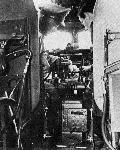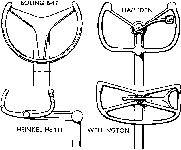Фотографии
-
The flight deck of the Boeing B-17, showing the unique throttle controls which allowed the engines to be controlled singly, in pairs or as a group.
Самолёты на фотографии: Boeing B-17E / B-17G Flying Fortress - США - 1941
-
Sketches of four control columns of the World War II period which were typical of the practice adopted by three of the major combatant powers.
Самолёты на фотографии: Boeing B-17E / B-17G Flying Fortress - США - 1941Handley Page Hampden / H.P.52 - Великобритания - 1936Heinkel He-111P/H - Германия - 1938Vickers Wellington / Type 271 - Великобритания - 1936
-
For the B-29 Superfortress, Boeing borrowed the European idea of a smoothly-contoured nose, the two pilots being seated well back but with a good all-round view through the many windows.
Самолёты на фотографии: Boeing B-29 Superfortress - США - 1942
-
The Bristol Blenheim provides a good example of the influence of flight deck layout on overall aircraft design. The original Type 142 Blenheim I had a short nose, with the pilot close to the windscreen and no "step".
Самолёты на фотографии: Bristol Blenheim - Великобритания - 1936
-
To provide the pilot of the Heinkel He 111 with the best possible view forward and downward, the aircraft's nose was almost wholly transparent, and the main instrument panel was suspended from the roof at eye level.
Самолёты на фотографии: Heinkel He-111P/H - Германия - 1938
-
Самолёты на фотографии: Heinkel He-111P/H - Германия - 1938
-
Регистрационный номер: K7072 For the Type 149 Bolingbroke (later Blenheim IV) a lenghtened but still blunt nose was introduced, allowing for a radio operator/navigator ahead of the pilot, but the windscreen position was found to be too far from the pilot's eyes, leading to design of the "stepped" nose.
Самолёты на фотографии: Bristol Blenheim IV/Bolingbroke - Великобритания - 1937
-
The Avro Anson of 1939 illustrates typical European practice for the period, with a single pilot position to the left and a gangway to the right giving access to the bomb aiming position in the nose.
Самолёты на фотографии: Avro Anson / Type 652 - Великобритания - 1935
Статьи







